From those on the streets: Colombia's students and the fight for a better future

In 2021, Colombians have taken to the streets to challenge their government on proposed tax reforms, their Covid-19 failures, and police brutality. Starting several months ago, the Colombian government is still making headlines for its use of excessive force this July.
As the protests continued into June, The Boar interviewed students involved in activism there. Angélica Barrera and Nicole Tiraldo detailed what young people in Colombia are demanding of their government.
TW: mention of rape and gendered violence
Have there been student protests across Colombia or have they only been occurring in Bogotá?
"Everyone around the country is protesting. The protests are not exclusive to students, although they are one of the many sectors of society playing an active role in the National Strike. The protests are not only happening in Bogotá but throughout the country: big cities, small towns. The reason why the protests in Bogotá are more visible is because it's the capital, where a lot of media attention is being directed. But in reality, Bogotá has not had the strongest demonstrations compared to places like Cali, Popayán, Pasto, which are some of the many places that have literally shed their own blood for these protests. "
"All of us have been touched by the injustice of this country"
"[People are protesting] even in places far from the big cities like San Vicente del Caguan in Caquetá. This is an area that has been largely neglected by the government, which was also quite affected by armed conflict. Even now, they still continue to be haunted by the ghosts of such violence…
One of the great problems of this armed conflict is that these soldiers who are recruited by both guerrillas and paramilitaries – most of them are peasants from very precarious areas, abandoned and forgotten by the government – they are poor people. People fall into this violence because, as many say: 'they eat better by being part of these groups.' That is why the unemployed are advocating for a better quality of life for everyone, not just for the usual big cities and for this reason those who protest are not only in the big cities.
Students are only a small part of those who go out to demonstrate and large cities. Although they host many people, they are not the only ones who protest, nor are the cities the places with the greatest force. Other groups of people fundamental to this march are: the indigenous minga, truck drivers, peasants, working people or people who cannot find work, teachers. All of us have been touched by the injustice of this country."
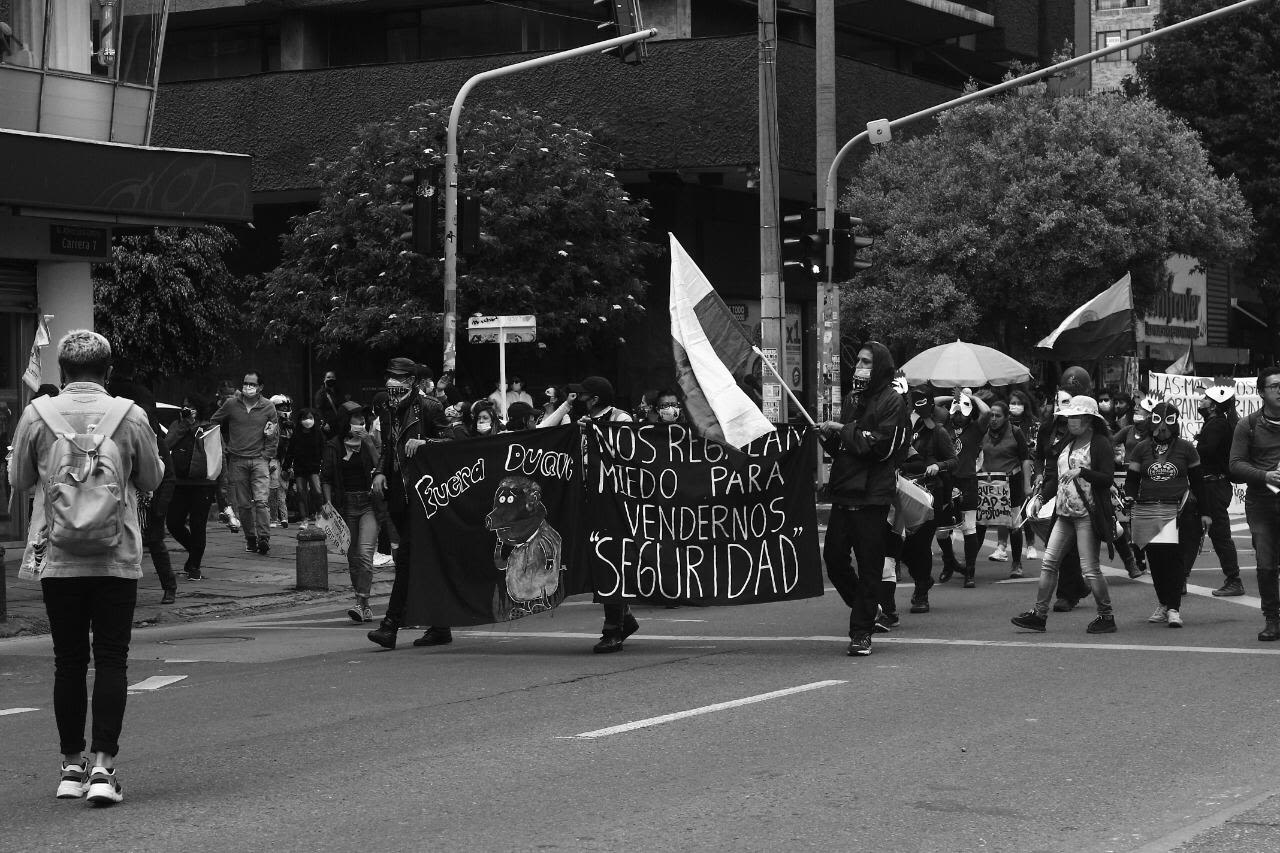
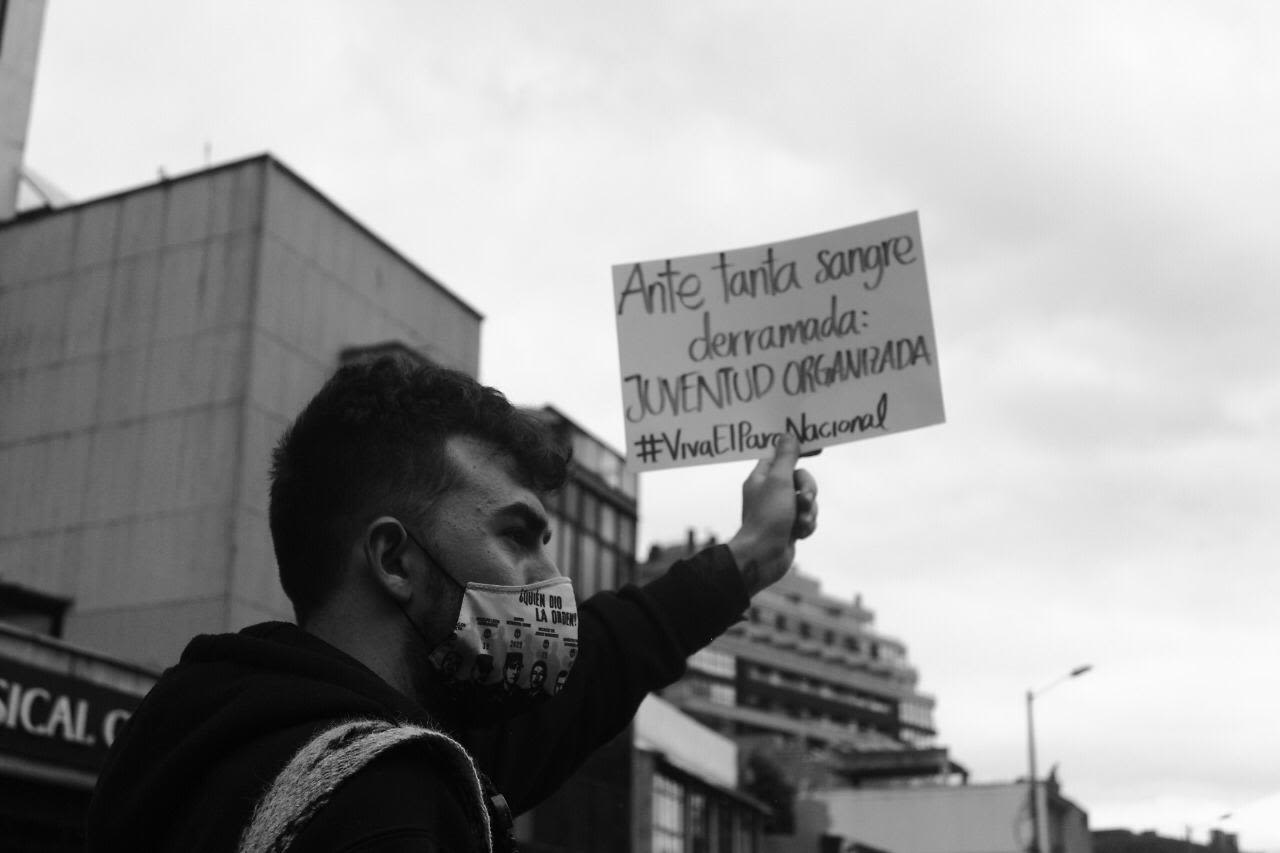
"In the face of so much blood spilled: the youth organised #longlivethenationalstrike"
¿Cuál fue el objetivo central de las protestas iniciales y por qué continúan protestando con uno de los objetivos clave logrados?

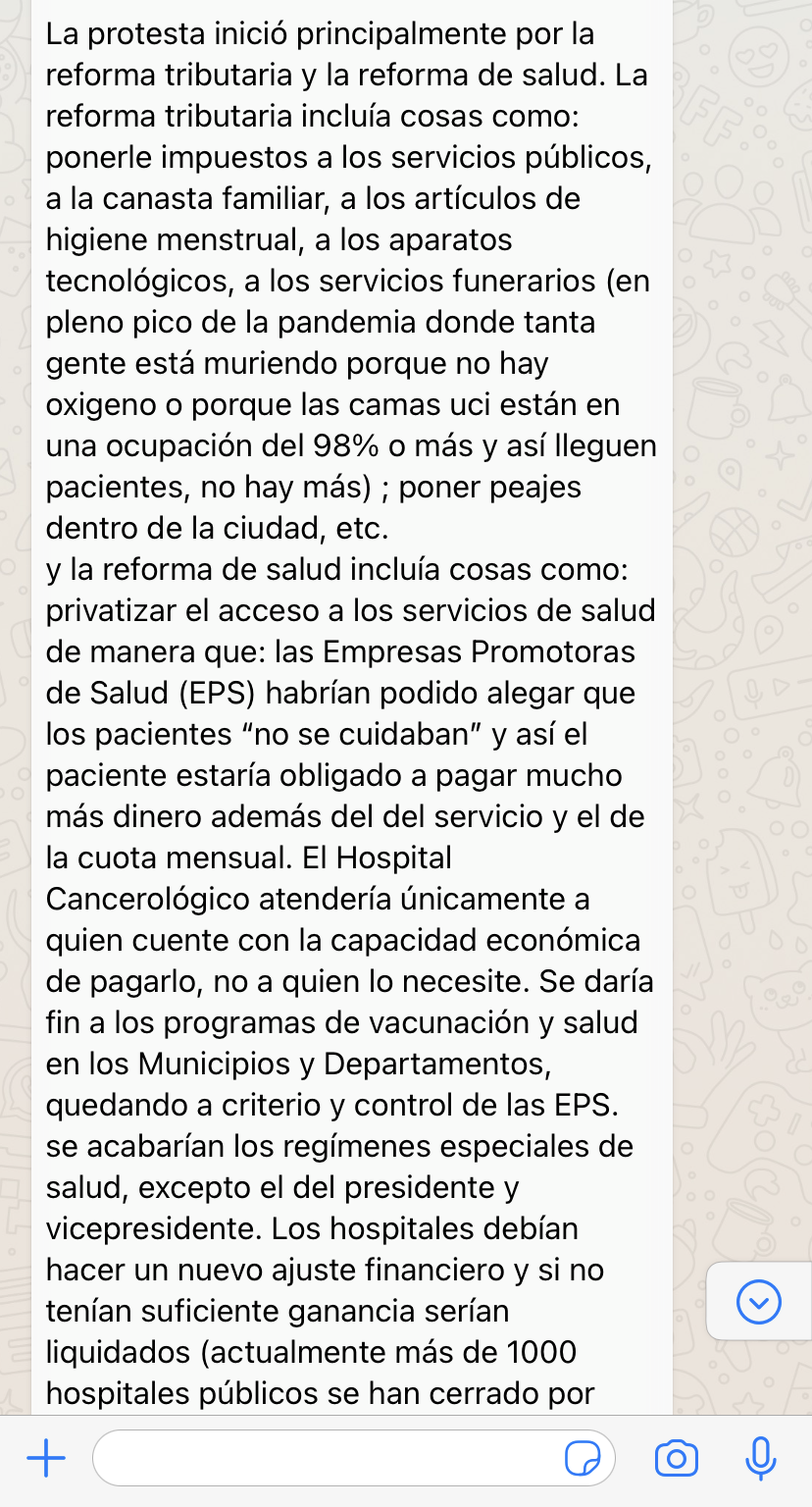
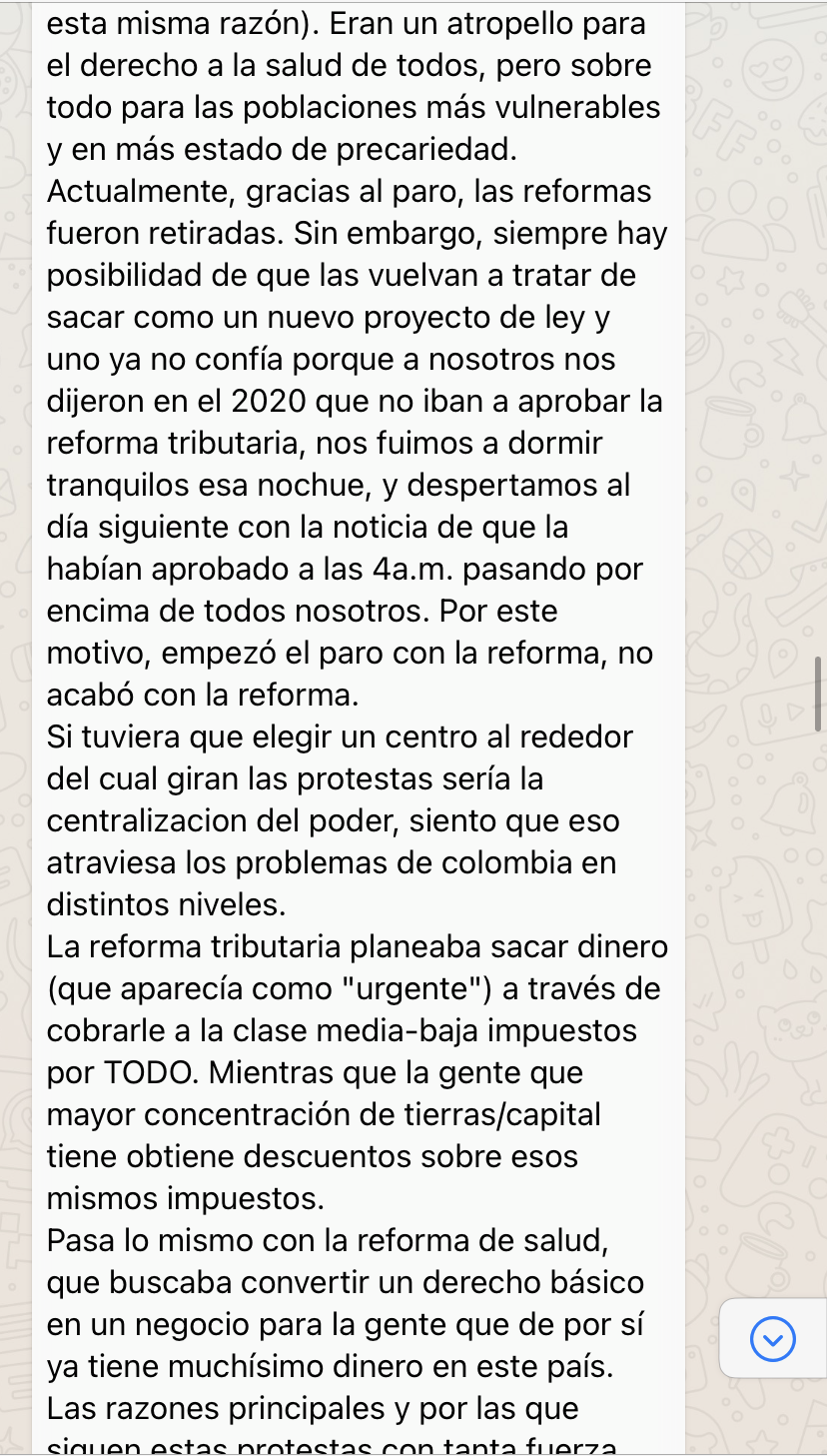
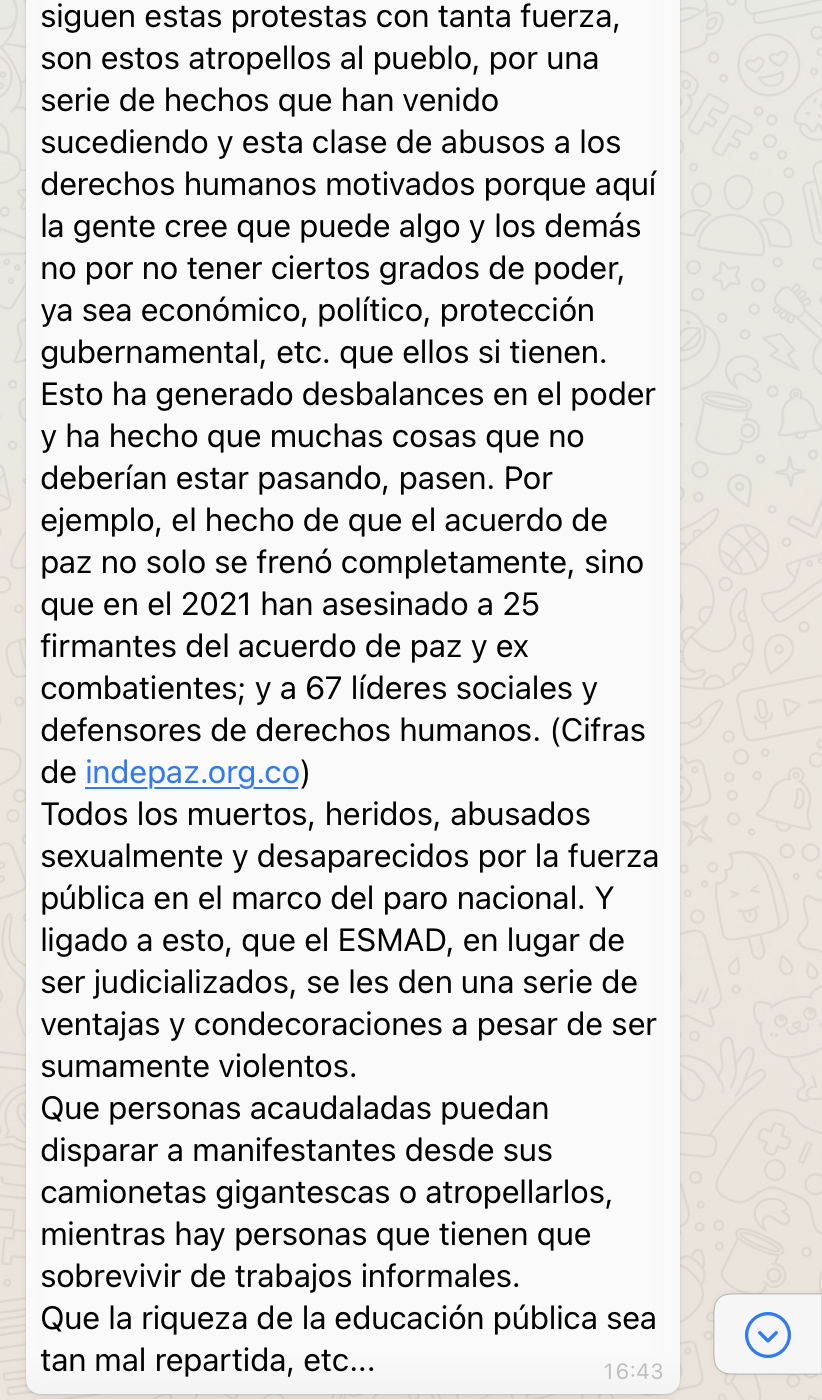
"The protest began mainly for tax reform and health reform. The tax reform included things like taxing public services, family planning, menstrual hygiene items, technological devices, funeral services (at the height of the pandemic where so many people are dying because there are no oxygen or because the ICU beds are at an occupancy of 98%). [These] put a toll on the city.
The health reform included things such as: privatizing access to health services in such a way that the Health Promoting Companies (EPS) could have alleged that patients 'did not take care of themselves', and thus the patient would be obliged to pay much more money in addition to the service and the monthly fee. The Cancer Hospital would only attend to those who have the economic capacity to pay it, not to those who need it. The vaccination and health programs in the Municipalities and Departments would be terminated, remaining at the discretion and control of the EPS. The special health regimes would end, except for the president and vice president.
The hospitals had to make a new financial adjustment and if they did not have enough profit they would be liquidated (currently more than 1000 public hospitals have been closed for this same reason). They were an outrage for everyone's right to health, but above all for the most vulnerable populations and in a more precarious state."
"One no longer trusts [them], because they told us in 2020 that they were not going to approve the tax reform; we went to sleep peacefully that night, and we woke up the next day to the news that it had been approved at 4 a.m"
"Currently, thanks to the strike, the reforms have been withdrawn. However, there is always the possibility that they will try to get them out as a new bill and one no longer trusts [them], because they told us in 2020 that they were not going to approve the tax reform; we went to sleep peacefully that night, and we woke up the next day to the news that it had been approved at 4 a.m. passing over all of us. For this reason, the strike began with the reform, but it did not end with the reform.
The tax reform planned to extract money (which appeared as 'urgent') by charging the lower-middle-class taxes for EVERYTHING, while the people with the highest concentration of land/capital have discounts on those same taxes. The same thing happens with the health reform, which sought to turn a basic right into a business for people who already have a lot of money in this country.
The main reason, and why these protests continue with such force, is this abuse of the people. Due to the series of events that have been happening and this kind of human rights abuse motivated people. [Certain people] believe that they can do something for having the certain degrees of power (be it economic, political, government protection) that they do, and others cannot. This has generated imbalances in power and has made many things that should not be happening, happen. For example, the fact that the peace agreement was not only completely stopped, but in 2021, 25 signatories of the peace agreement and former combatants have been assassinated; and 67 social leaders and human rights defenders. (Figures from indepaz.org.co).
All those killed, injured, sexually abused and disappeared by the public force have done so in the framework of the national strike. And linked to this, that the ESMAD (the Colombian riot police), instead of being prosecuted, are given a series of advantages and decorations despite being extremely violent. That wealthy people can shoot protesters from their gigantic vans or run them over, while there are people who have to survive from informal jobs."
How have recent events such as the pandemic and police actions influenced the protest?
"The problem of police repression is one of the engines that has sustained the protests the most because, in addition to those murdered, we already have 346 missing persons in the framework of the protests; we want to know where they are, why are their bodies appearing in rivers? And we want them to answer for sexual and physical abuse and punish the corresponding people for all these acts. Because the police do not have health protocols. The police, who must accompany and ensure the protection of the right to protest, are often the ones who cause conflicts.
We also understand that there are many systemic and justice problems; the perpetrators who carried out the attacks and homicides have not been investigated or prosecuted. In addition, there has been very bad management of the pandemic, we have barely started the third stage of vaccination, but even the figures are misleading.
Recently, the news came out with the names of people who had died many years ago who were registered as vaccinated. People no longer believe in their institutions because they are extremely corrupt – the videos of nurses pretending to administer the vaccine have gone viral and now people are waiting, with a camera and praying that they have not been deceived with the vaccine. There are also people who are not even close to being vaccinated, no longer have the monetary resources to stay without work or without leaving or living off informal jobs that no longer give the same support as before."
"More pencil, less bullets, more pencils, less weapons"
"...The government in the midst of a global pandemic, instead of helping people – buying adequate equipment for hospitals and protecting doctors or buying more vaccines – spent a lot of money on weapons. Meanwhile, people were starving, small businesses went bankrupt and people were left without work. We are the country with the second-highest military spending in Latin America in this critical and difficult time.
What the pandemic did was accentuate problems in Colombia that had already come for a long time and others more recently occurring – such as the peace process having stopped, the murders of social leaders, ex-combatants and signatories of the peace agreement, unemployment in the country, the difficulty in accessing education, the terrible health service. People got tired. And that is not new, this has been demanded for a long time – the protests began in 2019, and increased after the murder of Dilan Cruz in the centre of Bogotá by an ESMAD agent. These protests stopped only because Covid struck Colombia and we entered into quarantine, but it is 2021 and Dilan's mother is on the street marching because she wants to be answered for her son's death, she wants reparations and guarantee of the non-repetition of these events.
The police, as an extension of the state but part of the people, should ideally protect us, but support the same violent speeches of hatred and slaughter that our leaders repeat: that those who go out to march are vandals, that the indigenous should better return to their territory instead of marching for their dead, that anything justifies murdering people. Students are used a lot as scapegoats here. The media have justified the killings of young people by calling them 'vandals' – a term that can be used basically with anyone they need to eradicate because they are protesting.
Of course, there is a lot of talk here that in the marches there have been infiltrators and people who destroy public property. However, the vast majority march, dance, make art – but are still killed... In places where there is no ESMAD or police presence, it has been noted that there are never altercations, there are no vandals, there are no people who try to discredit the march; nothing happens, everything happens in tranquillity and that is not by chance. The police, the ESMAD and all this public force have generated a great stigmatization at the discursive level, and action against the protest.
The people who try to discredit the march... they always appear at the same time as the police. There are really very few [of them] compared to the vast majority who are marching, dancing, singing, making art – ESMAD's response to these few people is completely over the top.
According to the media and the police in this country, the 73 people killed were all vandals and the disappeared were probably the same. By being supposedly a 'vandal' , a person can be classified to have no rights. It is not possible only to get to shoot him in the face, in the body, [but to] to kill them. The police attack the entire march itself and they don't care about the people. It is as if they do not see people, but enemies."
"We continue for each missing person"
"There are already many videos that prove that the police themselves not only stigmatize the protest but also collaborate with the stigmatization. We found videos of plain-clothed police officers or 'civilians' who, after setting fire to something, get on motorcycles with other policemen or enter ESMAD trucks. The police in Colombia are not designed to protect rights but to repress and nullify protests in most cases. Police repression is an everyday thing.
I understand that the places where the marches have been more peaceful are places where there is no ESMAD presence, especially in the towns. In cities, protests usually end with tear gas, many injured, dead, raped, missing. It is not surprising, one here realizes that despite what the media say, many times it is the police force that begins to attack the population directly.
That is why now everyone records videos, they must have proof of what they are witnessing and for safety also try to record the numbers of the policemen's jackets because many of the murders are committed by members of the public force with the numbers identification tags covered. There are many terrible videos, of homicides even, where excessive violence is seen – for example, six policemen on motorcycles subjecting a single demonstrator without a weapon, or videos where the marchers are seen shouting "without violence", kneeling before the policemen and [the police] throw more gas or more bombs. That really is unjustifiable. They should not have the right to choose on the streets who lives and who dies.
And young people, especially, have access to this information quickly. We already know that the term 'vandal' [allows them] to justify non-humanitarian protocols to end the protest... Many of us know that no one should be shooting firearms directly at people, at their eyes… even more so because the police force is trained, has firearms, shields, armour, tanks [stronger than any weapons the people have]. It cannot be compared.
The people who go out to march are a majority of regular citizens with a stone and a piece of metal to protect themselves from everything [being] thrown. Nothing is being demanded other than a dignified quality of life where basic rights are respected: health, food, life, justice."
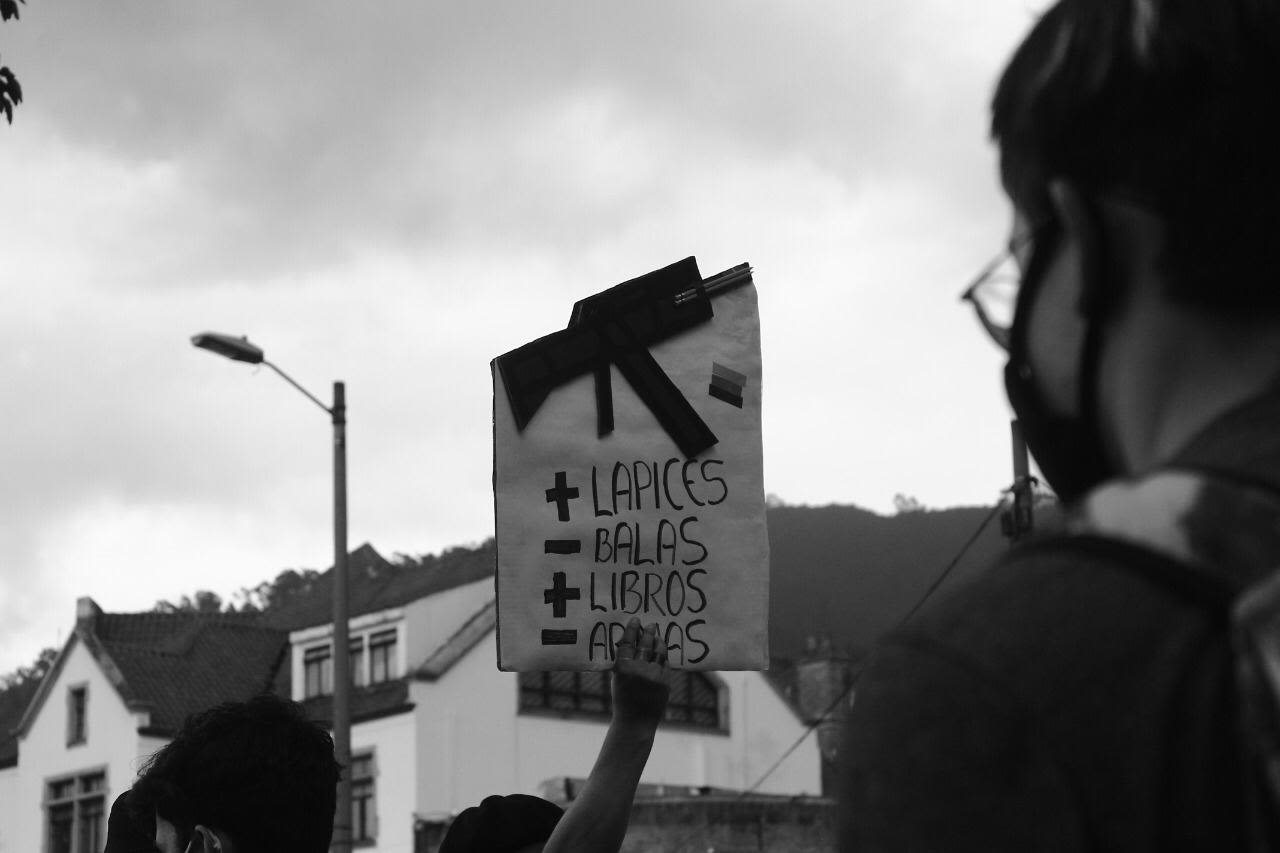
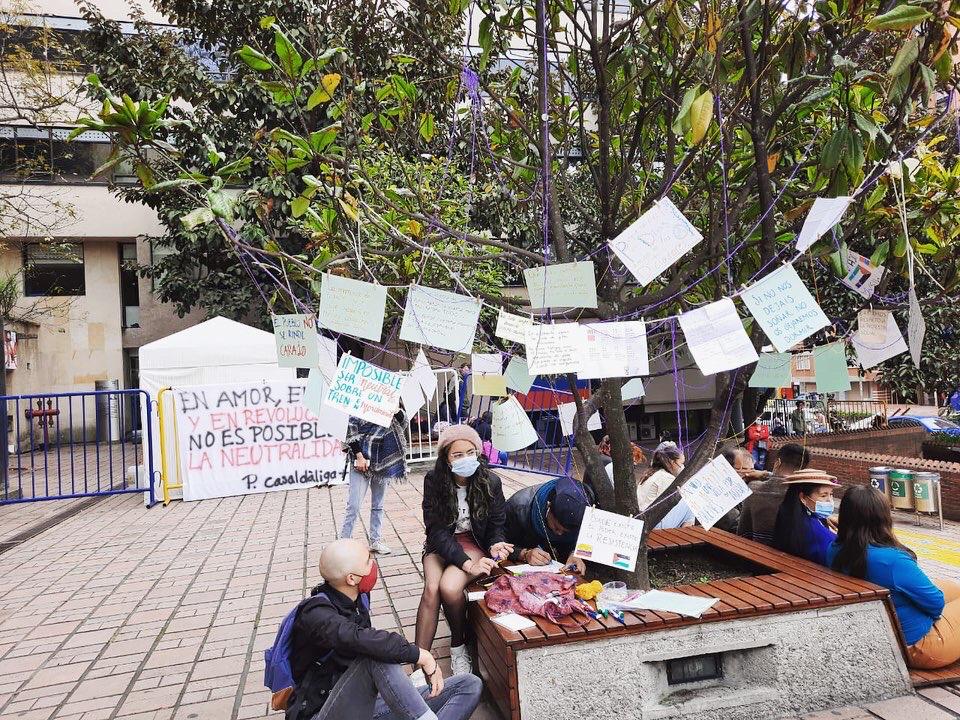
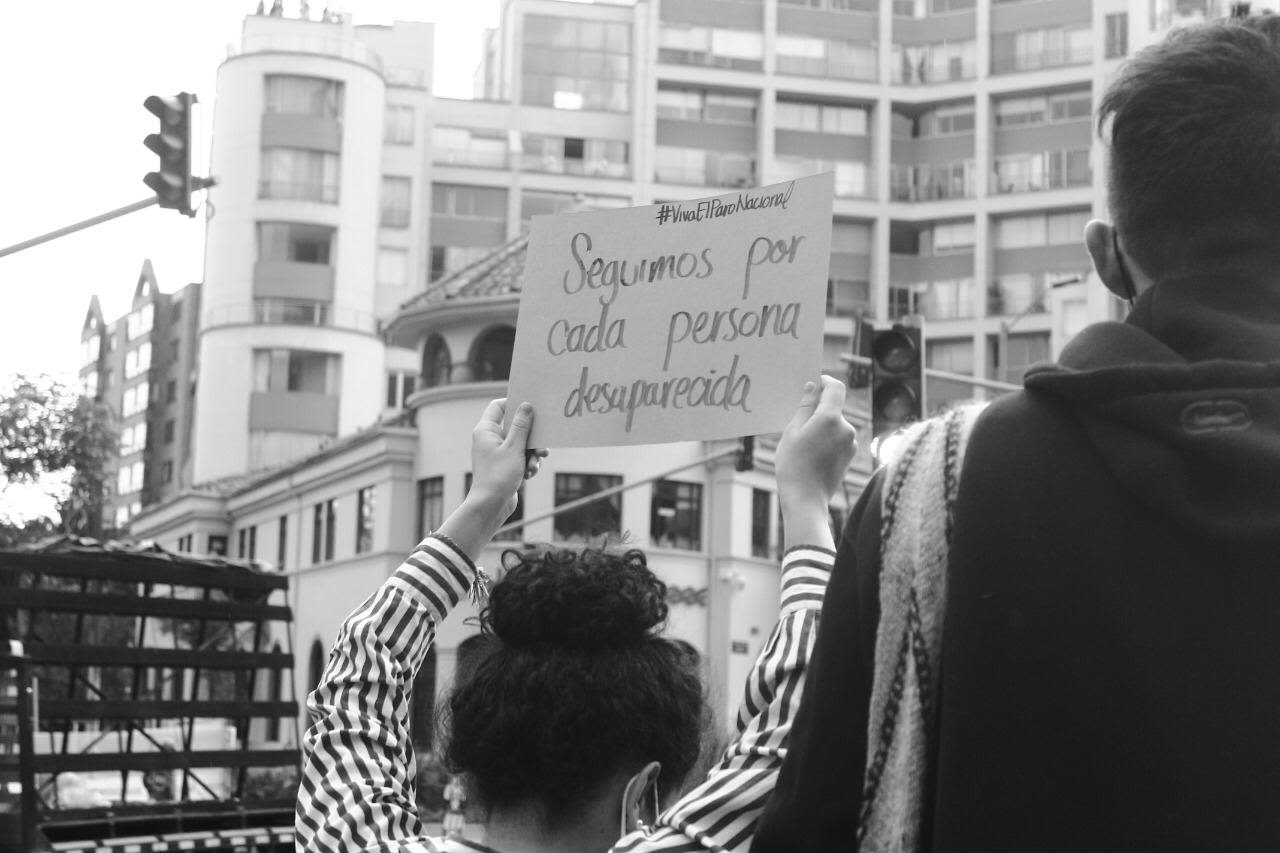
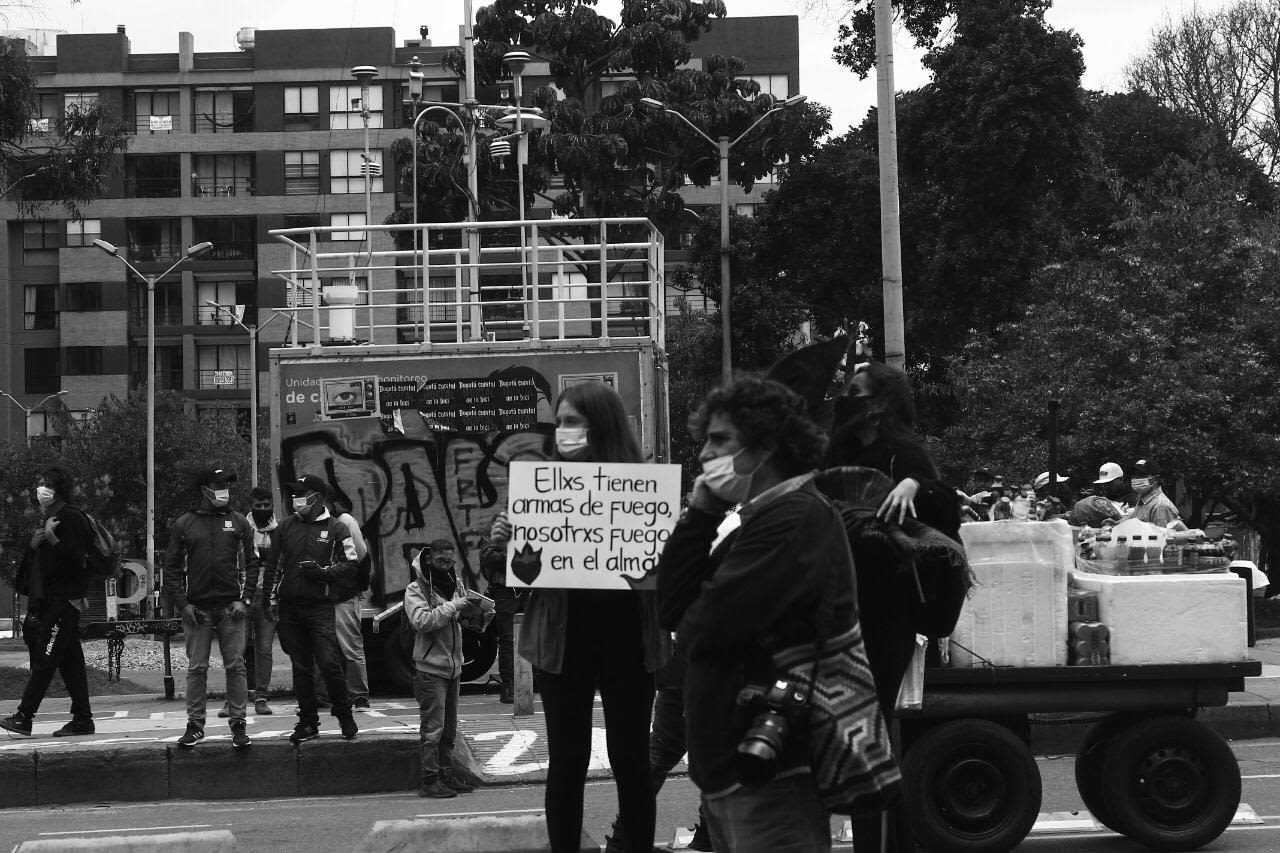
"They have guns, we have fire in our souls"
With the deaths and disappearance, are students deterred from participating in the protest?
"I believed yes and no… Of course, in these times youth is the easiest target because they are the ones who can appear to be thugs in Colombian society. And this is why the figures from 28 April to 8 May are so worrying... they put the victims by age range and there were four minors, 13 people between 18 and 25 years old, 12 between 26 and 36 years old, two older than 60 and 16 without identification.
So yes, young people are more vulnerable also because they are the ones who go out the most –because they have the opportunity to or because they are the most convinced that it is working. But the fear of going out is always there for some people. There are people who have developed stress and anxiety from traumatic confrontations with the police.
There are people who have lost eyes, friends, and life. There are women raped and there are also vulnerabilities due to gender. Colombia is still a very homophobic, transphobic and sexist country. The bodies of women have been used as spoils of war in these demonstrations, so when one leaves as a woman, in addition to worrying about whether they will come back alive, they must worry about other types of aggressions such as sexual and gender-based attacks.
There are mothers, fathers or relatives who do not let their daughters or sons set foot on the street because they do not know if they will come back alive because there is no guarantee of exercising the right to protest and leaving unharmed in this country."
"One of these care strategies is the reason why there is the first line, which are the people willing to put the body directly and first-hand when the ESMAD starts throwing things. It is these people that you can see in images with shields"
However, I would also say that it has not been an impediment at all, precisely because not only the students – but the people in general – continue to come out to protest after a month and many of them are not left alone with this fear. And it may sound very ugly but you know that when you go out you are exposed to certain things, that minimally you are going to get tear-gassed.
We already know that this is happening, that we are exposing ourselves and there are two options: we are left with fear and no one comes out, or we organize and create strategies. And what has happened is the second – people have had to organize to protect themselves, strategies were created such as creating communication channels to know where the ESMAD is, so that they know where one is at all times.
They are constantly hovering posts on how to protect themselves in protests – what to bring, for example: water for battling gases, telephone numbers of human rights persons. Informative posts about the rights that one has if the police catch you, what documents to give, what documents it is illegal for them to ask from you. Students have generated strategies of care among the protesters since the police do not take care of us. And also one of these care strategies is the reason why there is the first line, which are the people willing to put the body directly and first-hand when the ESMAD starts throwing things. It is these people that you can see in images with shields. They are the ones who truly protect many of those who come out.
Right now, this discourse is around a lot that everything is political, that those who leave are followers of a [opposition] politician and that everything is done for him, but doesn't it seem illogical? There are mothers on the *front line* demanding that they tell them where their children are who left to march and did not return."
"We are tired of reading the same Colombian history book a thousand times and living it every day, we want a different future"
"People are putting their lives at risk here, their bodies, their integrity, and there are thousands on the streets. This is not because of a politician or an ideology that was invented to scare people – students and people keep going out because it is more scary to know that they can starve tomorrow, that they can be fired from their job without guarantees, that they do not know when the pension will arrive, that the vaccination process is taking a long time, that your appointment for surgery may arrive on the day of your wake, that your best friend may disappear for being young and having been on the street on the day of the protests, that your sister can be raped by a policeman who will never be prosecuted, that your people can be massacred from a helicopter or in a supermarket without anything happening, that the indigenous minga can be shot by citizens with weapons – without the government prosecuting these people and justifying the deaths with obvious racism.
Those things at this point are scarier than going outside, even in those conditions of killings and disappearances. We are tired of reading the same Colombian history book a thousand times and living it every day, we want a different future. Without missing persons, without armed conflict, without our own government killing us in the streets. Therefore, strategies are created to reduce fear, to protect each other, and to continue coming out.
Sure, there will be people who cannot, or want to but their fear will not let them – and that is also valid. But many of these people are actively participating from other areas. They are the ones who take care of and are aware of where you are when you go out, they are the ones who pass by and broadcast human rights telephones. The protest does not stay alone in the houses and in the virtual, nor does it remain alone in the streets. It is a mixture of both, but without a doubt the importance of going out and of these people who put their bodies to change things are fundamental."
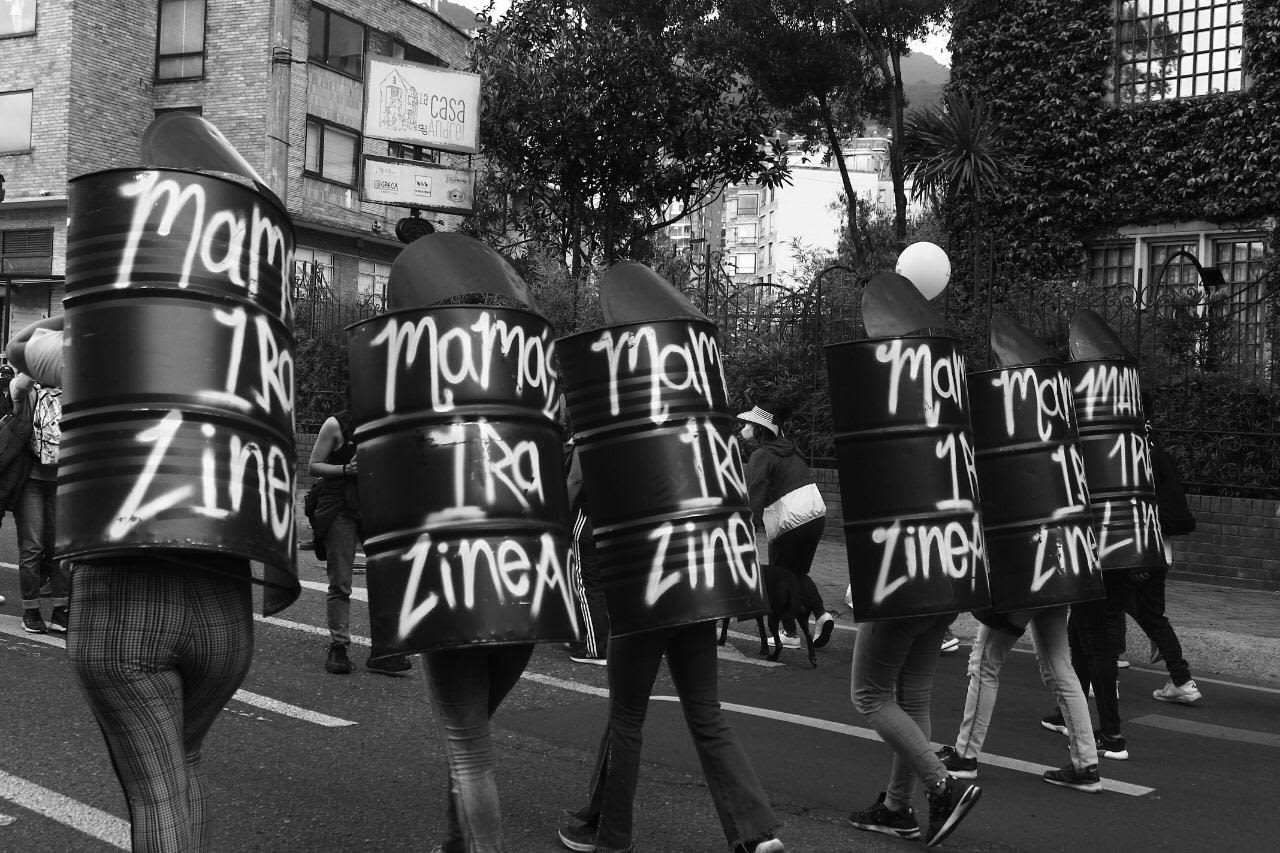
How have recent events surrounding the protests in general, issues of corruption within the central government made the Colombian population and Colombian students feel as a whole and about their futures?
"Something very interesting about these protests is that they manifest what everyone had been thinking for many years, but that nobody knew what to do about it. I mean, it's not that we literally opened our eyes in 2019/2021 and realized everything that was wrong and corrupt.
Here it was always known that everything was wrong and it would be normalized because people did not know that they were capable of demonstrating against and not just complaining... What there was, was a discovery of the agency and the ability to focus these complaints, anger, sadness, frustration. Because here we have not had good leaders at all.
"I can answer you that we feel that this country is more of a mass grave than a country"
Our rulers right now are only a very great representation of everything that has been going wrong in the country for a long time – a country with a government not very open to dialogue, that is capable of killing its people just because it does not agree with them or because it suits them or because it does not fit into this mould of what they called a "good person", and who is also capable of manipulating the discourse to justify it. It is a history that repeats itself for years, although less big than right now or at least more hidden. It is a government run by the same racist, classist, sexist and power-hungry people who do not release a position of power. It is not something new – my grandparents have complained about it since they were young. What has happened is that this government has been especially violent and people have already realized that something can be done.
If you ask me how we feel about the events that have happened, I can answer you that we feel that this country is more of a mass grave than a country, and to understand that so literally is scary. But regarding the future - it is uncertain. Although it sometimes seems that it is really difficult to change everything that is badly rooted [in our country]... if there was no hope, if we had given up, we would not resist in the streets – in the academy, in art, in journalism. There is truly a belief in transforming the voices of our unhappy mothers, fathers, grandmothers and grandfathers into action.
Seeing so many people on the street, seeing that after a month and with everything that has happened they have not been able to shut us up, gives some hope. I don't know if our future will be as we expect it to be, if all the proposals work, but at least we know that we have the agency to try to build something much better than what they were imposing on us."
Questions from Shannon McGuigan, translations by Sabrina Penty.

